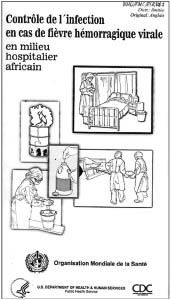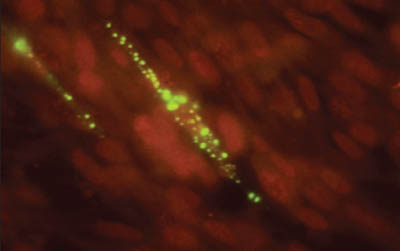|
· Nairobi sheep disease - no hepatitis, not in newborn lambs · Bluetongue - mouth and foot lesions (coronitis) · Heartwater - serous fluids in body cavities; neurological signs · Ephemeral fever - recumbency and rapid recovery · Wesselbron - rare viral disease, less severe than RVF · Toxoplasmosis, leptospirosis, brucellosis, Q fever, salmonellosis - basic diagnostic methods for differentiation · Peste des petits ruminants - high mortality in lambs · Foot-and-mouth disease - neonatal mortality and abortions in small ruminants |
Single cases of RVF can be confused with many viral diseases, which cause sudden death in sheep and produce generalized lymphadenopathy and petechial and ecchymotic haemorrhages throughout the carcass. However, RVF manifests itself in a dramatic fashion with the following:
a sudden onset of many abortions at all stages of pregnancy; these may affect an extensive area or be countrywide
an acute febrile disease with high fatality rates in young animals
liver lesions are present in all cases
associated with high mosquito populations and/or flooding of grasslands
may be associated with an influenza-like disease in humans
The diseases that may be manifested in this manner are described below.
Nairobi sheep disease causes abortions, high fatality rates and produces gastroenteritis in sheep and goats. This does not show a higher pathogenicity for neonates, however, which is a feature of RVF, and while it does cause abortions, these and the clinical disease are of a more sporadic nature. Deaths are usually in older animal age groups, and the carcasses have similar haemorrhages, but there is no hepatitis.
Bluetongue causes a febrile disease often with diarrhoea, but also causes muzzle oedema and mouth lesions, which will be obvious in some cases. Hyperaemia and erosion of the buccal mucosae, lameness and coronitis with skin hyperaemia will assist in making a clinical differentiation. Sudden deaths at the viraemic stage produce generalized petechial and ecchymotic haemorrhages, which on postmortem appear similar to RVF. There is no hepatitis.
Heartwater can cause sudden death with lymphadenopathy and generalized haemorrhages throughout the carcass. There is no hepatitis and usually the fluid in the serous cavities will be excessive and obvious. Neurological signs can be seen. Brain smears can be prepared to make a definitive diagnosis.
Ephemeral fever produces a clinical syndrome in dairy cattle that is very similar to RVF. There is a sudden onset of fever of a similar nature to RVF but generally more severe. The dysgalactia that occurs is the same, together with nasal and ocular discharges. However, the muscle weakness and recumbency, which are a feature of ephemeral fever cases, do not occur with RVF. Ephemeral fever does not produce any disease in sheep, goats or young cattle.
Wesselbron virus has been confused with RVF in South Africa, where it appeared to produce similar lesions and occurred in similar circumstances. This has not presented a problem elsewhere in Africa, nor in subsequent epizootics in South Africa.
Toxoplasmosis, leptospirosis, brucellosis, Q fever and salmonellosis all feature as possible differential diagnosis for RVF. However, they are not present in such an explosive manner over large areas simultaneously. They are not associated with rainfall, nor do they produce such high neonatal mortality. Good supportive laboratory competency is required to make a diagnosis.
RVF antigen detection
Agar gel diffusion test
Virus isolation in mice/hamsters/tissue culture
RT-PCR identification of RVF virus
Capture ELISA test
Immunochemical staining of fixed tissues
RVF antibody detection
ELISA tests for IgM/IgG
Indirect immunofluorescent/peroxidase tests
Microtitre virus-serum neutralization tests
Indirect haemagglutination tests
Plaque reduction assays
The International Office of Epizootics (OIE) Manual of standards for diagnostic tests and vaccines contains guidelines on the collection of samples and the diagnostic techniques for diagnosis of RVF infection.
RVF should be suspected if there is a sudden onset of large numbers of abortions in cattle, sheep, goat or camel populations associated with a high neonatal mortality and the presence of liver lesions. Cases of disease in people associated with the affected animals also assist in making a tentative diagnosis. A provisional diagnosis may be based upon the clinical picture, climatic and ecological factors such as the presence of huge mosquito populations, together with the explosive nature and onset of the disease.
RVF is a member of the human haemorrhagic fever group of viruses, such as Ebola and Crimean Congo haemorrhagic fevers. These viruses present a serious hazard to all personnel handling infected carcasses, blood and other tissues both in the field abattoir and in the laboratory. For this reason it is recommended that field veterinarians and laboratory personnel be vaccinated against RVF, if this is possible. The handling of RVF infected material should only be carried out under P-2/P-3 conditions or with type II biosafety cabinets and HEPA filtered respirators, where the security of the staff can be assured. For this reason, the appropriate diagnostic procedures are dependent upon the facilities available.
There are two types of test. The first is to identify or isolate the RVF virus or antigen and the second to demonstrate the presence of rising titres of RVF specific antibody or IgM. The test system chosen will depend upon the facilities available that can be safely used.
Detection of RVF virus/antigen
A simple agar gel double diffusion test, with test tissue (liver or spleen) and with RVF positive and negative control antigens and immune sera
Antigen capture ELISA test systems are available for the RVF virus antigen
RT-PCR (reverse transcription-polymerase chain reaction) identification of the RVF virus
Virus isolation in suckling or weaned mice, or hamsters by intraperitoneal inoculation (mice and hamsters die within three to four days)
Virus identification in tissue culture - the RVF virus may be identified in culture within 12-36 hours by immunofluorescent or peroxidase staining of the fixed cells
Cryostat sections of formalin fixed tissues and staining for RVF by immuno-histochemical methods
Histopathology of the liver showing characteristic RVF hepatic necrosis with intracytoplasmic and intranuclear inclusion bodies
Control of infection in case of haemorrhagic fever in African hospitals

WHO
Detection of specific antibody to the RVF virus
ELISA system for IgM antibody
ELISA system for IgG antibody
Microtitre virus-serum neutralization tests in tissue culture
Plaque reduction tests in tissue culture
*Indirect immunofluorescent test
*Indirect haemagglutination test
*These tests may detect low titre cross-relationships with other Phleboviruses, but high titre positives will be specific, i.e. 1/160 to 1/320 or greater.
RVF virus antigen in cell cultures 24 hours post inoculation with specimens for diagnosis

GLYN DAVIES
Specimen collection for RVF diagnosis
Refrigerate but do not freeze.
Blood in EDTA or heparin
Aliquots of liver, spleen or lymph nodes on ice
Similar tissue specimens in buffered formalin
Foetal liver and spleen on ice
Clotted blood for serum for serological testing (decant serum or remove clot before sending)
All tissue samples should be transported preferably in a phosphate buffered saline/glycerol suspension. Samples in buffered formolin may be transported in unfavourable conditions for many days without any deterioration. See the OIE Manual of standards for diagnostic tests and vaccines for further details.
What samples should be collected in an outbreak?
At an outbreak site, where sheep, cattle or camels are aborting and there are deaths in neonates, it is suggested that the following samples be collected:
at least 10-20 serum samples from animals that have recently aborted
10-20 samples from animals that have not aborted
blood in anticoagulant from any animals with a fever of 40.5-42°C
liver and spleen from any freshly dead animals, on ice, in glycerol buffered saline and/or in buffered formalin
liver, spleen and brain from fresh foetuses
What information is required?
The following basic information should be collected:
sampling site with map reference or full address
owner’s name, contact address, telephone, etc.
herds/flocks/breeds/strains affected, numbers and age groups
date of first case/date sampling
no affected/no dead/no abortions/age groups
full clinical history
presence/absence of febrile human disease
basic ecological characteristics of affected area